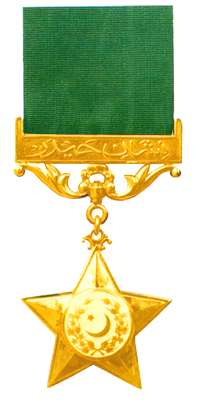Shabbir Sharif
Major Rana Shabbir Sharif (Urdu: رانا شبیر شریف; c. 28 April 1943 – 6 December 1971) was a military officer in the Pakistan Army who was posthumously awarded the Nishan-e-Haider during the Indo-Pakistani War of 1971.[1][2] He is the only person ever who received both the Nishan-e-Haider and Sitara-e-Jurat for his bravery.[3][4] He is regarded as the most decorated officer of the Pakistan Army.[5]
Shabbir Sharif | |
|---|---|
| Native name | Rana Shabbir Sharif[1] |
| Born | 28 April 1943 Kunjah, Gujrat District, British Raj |
| Died | 6 December 1971 (aged 28) Okara District, Punjab, Pakistan |
| Allegiance | |
| Service/ | |
| Years of service | 1961–1971 |
| Rank | |
| Service number | PA-6911 |
| Unit | 6 Frontier Force Regiment 4 Frontier Force Regiment |
| Battles/wars | Indo-Pakistani War of 1965 Indo-Pakistani War of 1971 |
| Awards | Sitara-i-Jur'at Sword of Honour |
| Relations | General Rana Raheel Shareef (brother) Raja Aziz Bhatti (uncle) |
Early life and education
Sharif was born on 28 April 1943 in a Rajput family[1][2][6] at Kunjah, Gujrat District to Major Rana Muhammad Sharif.[7] He attended St. Anthony's High School, Lahore. While at Government College Lahore, he received a call to join Pakistan Military Academy (PMA) Kakul.
He used to play squash and won an Army level swimming medal while he was in 4th Frontier Force Regiment.
Military career starting
He was commissioned in Pakistan Army on 19 April 1961 and after successfully completing his training, after which he was awarded the Sword of Honor, he was posted to the 6th Battalion of the Frontier Force Regiment.[5]
Death
In the Indo-Pakistani War of 1971, the Pakistan Army launched an offensive on the Western front against the enemy. Sharif, as commander of a company of 6 Frontier Force Regiment, was ordered to capture high ground overlooking Grumukhi Khera and Beri, a village in the Sulemanki Sector.
On 3 December 1971, in a well-organised action, he fought alongside his men and held Indian attacks at bay. He cleared the Jhangar post by passing through the minefield laid by enemy and swimming across a water obstacle, the 'Sabuna distributary', whilst under intense enemy fire and led his company to capture the objective.
On the afternoon of 6 December, the enemy launched an offensive preceded by air strikes and heavy artillery shelling. After casualties amongst the crew, he took over as a gunner on an anti-tank gun and started firing on the enemy tanks. While this fight was on, one of the enemy tanks fired at him thus killing him. His last words were quoted as: “Don’t lose the bridge.” It was the same bridge he died defending from the enemy's attack.[5][8]
Family
His younger brother, General Raheel Sharif was the Chief of Army Staff (November 2013 - November 2016), the highest rank in the Pakistan Army.[4] He is also the relative of another Nishan-e-Haider holder, Raja Aziz Bhatti.[6]
In popular culture
An Indian Malayalam film, 1971: Beyond Borders,[9] was inspired by the story of Rana Shabbir Sharif.
Awards and decorations
| Nishan-e-Haider Award Recipient | |
|---|---|
 Shabbir Sharif received the Nishan-e-Haider Award.[5] | |
| Date | 1971 |
| Country | Islamic Republic of Pakistan |
| Presented by | Zulfiqar Ali Bhutto |
Other awards he won are:
References
- "From Sharif to Sharif". nawaiwaqt.com.pk (in Urdu). 29 November 2013. Archived from the original on 4 March 2016. Retrieved 29 October 2014.
- "Legends:Maj. Shabbir Sharif". dailytimes.com.pk. 19 September 2015. Archived from the original on 4 March 2016. Retrieved 4 March 2016.
- Samaa TV Shabbir Sharif Rana
- "Sharif Tribute to Major Shabbir Sharif". The Nation. 11 December 2011. Retrieved 13 September 2014.
- "Army's 'superman' remembered". The Nation. 7 December 2014. Retrieved 9 December 2014.
- "Luck plays role in Gen Sharif's promotion". The News. 28 November 2013. Retrieved 23 July 2014.
- "Lahore remembers heroes of 1965".
- Afzal, Brig (Retd) Farooq. "TOGETHER WE FOUGHT". Cite journal requires
|journal=(help) - "1971 Beyond Borders movie review: This Mohanlal film is ill-conceived, powerless".
External links
- Article on Major Shabbir Sharif by Nasir M. Khan at the Wayback Machine (archived 27 October 2009)
- Major Shabbir Sharif